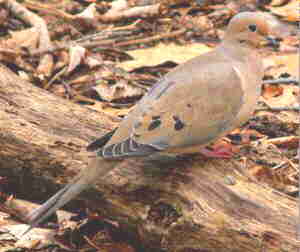 SKC Films Library SKC Films Library |
| SKC Films Library >> Science >> Zoology >> Birds >> Order Columbiformes |
| Mourning Dove Zenaida macroura [zen' A duh ma crO yoor uh] Description The mourning dove is 8.5 to 14 inches long, has a wingspan of 5.5 to 6 inches, and weighs 3 to 6 ounces. Its plumage is generally grayish blue to grayish brown on the back, with black spots on the wings and behind the eyes, and white tips on the tail. It has a small, black bill; and red legs and feet. Males are slightly larger and brighter in color than females, and have a bluish crown and rosy breast.
Distribution and Habitat Mourning doves range from southern Canada through the United States into Central America, including offshore islands. They are well adapted to a wide variety of habitats, including areas inhabited by humans, but are more common in open woodlands and forest edges near grasslands and fields. Reproduction Breeding takes place from February through October, and a breeding pair may breed more than once the year. Mourning doves form monogamous breeding pairs, but those pairs may break up at the end of the season. The male performs a courtship display to lure the female and induce her to mate. He then "offers her" a selection of nesting sites, from which the female chooses the one she "likes best." Most of the nest building is done by the female, but the male does his part by bringing materials to her. The nest itself is generally a rather flimsy structure constructed with twigs, conifer needles, and or grass blades. Although usually built in a tree, mourning doves will also take advantage of artificial structures, including building niches and even hanging flower pots. The female usually lays two small, white eggs per clutch. Both parents share in incubation, which takes about 14 days. The squabs fledge at about 15 days, but will remain around the nest until about 30 days of age, during which period both parents will share in feeding duties. They will be sexually mature at about 85 days. Diet Seeds make up the majority of the mourning dove's diet, with some grain, fruit, and insects also being eaten. Migratory Behavior Mourning doves will migrate south in the fall, with those in the far northern parts of the range traveling up to 1,000 miles one-way to reach their winter homes. Scientific Classification phylum Chordata SEE ALSO |
| SKC Films Library
>> Science
>> Zoology >> Birds >> Order Columbiformes This page was last updated on June 14, 2017. |
